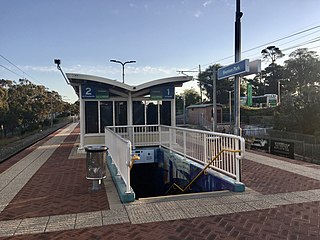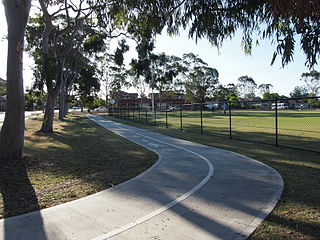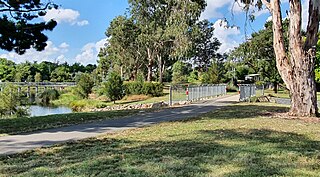

Cycling in Perth, Western Australia is common on the roads and paths for recreation, commuting and sport. Between 1998 and 2009 the number of cyclists in Perth increased 450%. [1]


Cycling in Perth, Western Australia is common on the roads and paths for recreation, commuting and sport. Between 1998 and 2009 the number of cyclists in Perth increased 450%. [1]
Bike lanes exist on some of Perth's major roads while many others have parallel shared paths.

There are some bike routes and recreational paths in Perth that are popular for cycling for the pleasure of a day or evening out of doors or for light exercise, or as a way of getting around. Most are interrupted by road crossings, road works, slow points or just end abruptly. Many new developments have caused disconnection in what was a previously continuous shared paths such as Elizabeth Quay, the new[ timeframe? ] Scarborough Beach redevelopment and the Reid Highway / Mitchell Freeway overpass. Nearly all of the paths are "shared paths" – shared by cyclists, pedestrians and other users. Some of the major routes include:
Also Rottnest Island, 19 km off the coast of Fremantle, is ideal to explore by bicycle because private vehicles are not permitted on its roads.
There are also rail trails and long-distance trails, such as the existing Railway Reserve Heritage Trail, and the Munda Biddi Trail, which runs 1,000 kilometres from Mundaring in the Perth Hills to Albany on the state's south coast. [3]
The Perth Principal Shared Path (PSP) network is a web of off-road paths that form the backbone of the Perth Bicycle Network. [4] PSPs are shared pedestrian and bicycle paths that primarily follow freeway and rail corridors, they have a high degree of separation from traffic utilising bridges and tunnels to bypass intersections. The PSP network is constructed according to the Western Australian Department of Main Roads Standards and Guidelines for Shared Paths. [5]
The Western Australian Government has a policy of including the construction of Principal Shared Paths when building major road projects such as the Gateway WA Project and the Forrest Highway. The rollout of PSP routes along railway corridors is largely complete within 10 km of the Perth Central Business District however work continues on the construction of PSP paths adjacent to the rest of the radial Perth rail network.
Those who do not wish to ride the whole way to their destination can mix their commute with public transport by park and riding or by taking their bike with them on the train except during main commuting times mornings and evenings where bikes are prohibited on trains.
Commuting is made easier by park and ride facilities at Perth train stations. There are different types of bicycle parking. A guide published by TransPerth outlines the bicycle facilities available at each Perth train station as well as the rules and regulations around bicycles and public transport. [6]
Transperth's bike shelters are secure sheds for locking your bicycle in at Perth train stations, they can be accessed by anyone who registers their Smartrider for access on the Transperth website. Users may register for access to a maximum of two bike shelters on the Transperth network at any one time, users can access the bike shelter 24 hours a day.
As of October 2009 [update] there are approximately 450 bike lockers at suburban railway stations and major bus stations throughout the metropolitan area although no more than 3 at any one location. Where available lockers have been positioned in areas monitored by surveillance (closed circuit TV). Users are required to provide their own lock (D lock or padlock) and observe the Conditions of Use that are displayed on alternate doors of each locker set. It is recommended that a top quality padlock that has a hardened steel body and shank be used for security purposes.
Over 200 bike racks are provided at suburban railway stations and major bus stations in the Perth metropolitan area. These facilities are usually located on or near platforms for convenience and security purposes.
Bikes are permitted on all Transperth train services except for city-bound morning peak (weekdays 7.00am and 9.00am) services and trains heading out of the city in the afternoon peak (weekdays 4.30pm and 6.30pm). Bikes cannot depart or pass through Perth, Perth Underground or Elizabeth Quay stations in any direction during these periods – Transperth asks that cyclist get off, ride through the city, then re-board outside of these stations.
Folding bicycles are however permitted in peak times as long as they are in a carry bag, exceed no more than 79 cm x 59 cm x 36 cm in size, and are kept out of the aisles.
Bikes (excluding folding bicycles) are not allowed on any Transperth bus services.
There are many cycling-related recreational, social and charity events [7] every year in Perth as well as events to promote cycling in general, such as Ride to Work day and the Cycle Instead Challenge. [8] This is based on the Cycle Instead social marketing campaign, coordinated by the WA Department of Transport, which was established in October 1999. [9]
As with other cities in Australia road cycling has become a popular pastime and sport. The organization Cycling Western Australia [10] organises, facilitates and promotes many road racing events, including Western Australia's premier road cycling event, the Tour de Perth. [11] Perth also hosts the premier track cycling event called Perth International Track Cycling Grand Prix. There are also many mountain bike events. [12]

A bike path or a cycle path is a bikeway separated from motorized traffic and dedicated to cycling or shared with pedestrians or other non-motorized users. In the US a bike path sometimes encompasses shared use paths, "multi-use path", or "Class III bikeway" is a paved path that has been designated for use by cyclists outside the right of way of a public road. It may or may not have a center divider or stripe to prevent head-on collisions. In the UK, a shared-use footway or multi-use path is for use by both cyclists and pedestrians.

Cycling in Melbourne, the capital city of Victoria, Australia, is enhanced by the city's relatively flat topography and generally mild climate. The city has an active cycling culture for commuting, recreation, fitness and sport, and the metropolitan area has an extensive network of off-road bicycle paths, as well as designated bicycle lanes on many streets.

Shenton Park railway station is a commuter railway station in Shenton Park, a suburb of Perth, Western Australia. The station is on the Fremantle and Airport lines, which are part of the Transperth public transport network. It has an island platform, accessed by a pedestrian underpass. The station is only partially accessible due to a steep ramp. Services on each line run every 12 minutes during peak hour and every 15 minutes outside peak hour and on weekends and public holidays. At night, trains are every half-hour or hour. The journey to Perth railway station is 6.0 kilometres (3.7 mi), and takes 9 minutes.

Daglish railway station is a commuter railway station on the boundary of Daglish and Subiaco, suburbs of Perth, Western Australia. Opened on 14 July 1924, the station was named after Henry Daglish, who had been a mayor of Subiaco, a member for the electoral district of Subiaco, and a premier of Western Australia in the 1900s. Daglish was a resident of Subiaco for 22 years before he died in 1920. The station consists of an island platform accessed by a pedestrian underpass. Two small buildings are on the platform which operated as a parcels office and ticket office until 1970. The station is only partially accessible due to a steep access ramp and lack of tactile paving.

Claremont railway station is a railway station on the Transperth network in Western Australia. It is located on the Fremantle and Airport lines, 9.3 kilometres from Perth station serving the suburb of Claremont.

Since the advent of the bicycle in the 1860s, Chicago has been distinguished as one of the premier cycling locations in the United States, with such public cycling destinations as Grant Park, Burnham Park and the Chicago Park District's Lakefront Trail.

Cycling is the second-most common mode of transport in the Netherlands, with 36% of Dutch people listing the bicycle as their most frequent way of getting around on a typical day, as opposed to the car (45%) and public transport (11%). Cycling has a modal share of 27% of all trips nationwide. In cities this is even higher, such as Amsterdam which has 38%, and Zwolle 46%. This high frequency of bicycle travel is enabled by excellent cycling infrastructure such as cycle paths, cycle tracks, protected intersections, ample bicycle parking and by making cycling routes shorter and more direct than car routes.
Transport in Perth, Western Australia, is served by various means, among them an extensive highway / freeway network and a substantial system of commuter rail lines and bus routes. Public transport is managed by the Transperth agency.

Cycling in Sydney, New South Wales, Australia takes place for recreation, commuting and as a sport. Sydney has a hilly topography and so may require a slightly higher level of fitness from cyclists than flatter cities such as Melbourne and Canberra. Sydney depends heavily on motor vehicles where traffic and public transport operate at capacity. This means that cyclist are often competing with motorists for limited space on busier roads, and for limited government resources for expenditure on road infrastructure. In its favour, Sydney has a generally mild climate and there are active cycling groups.

Bike paths around Melbourne have been developed over many decades. Many off-road trails follow current or former watercourses and traverse long distances, so that responsibility for planning and maintenance is split between various State Government authorities and local councils. With the increased recognition from all levels of government of the benefits of cycling, Melbourne today has a network of shared bicycle trails which have developed over time along its river and creek systems and alongside freeways and railways.

Toronto, Ontario, like many North American cities, has slowly been expanding its purpose-built cycling infrastructure. The number of cyclists in Toronto has been increasing progressively, particularly in the city's downtown core. As cycling conditions improve, a cycling culture has grown and alternatives such as automobiles are seen as less attractive. The politics of providing resources for cyclists, particularly dedicated bike lanes, has been contentious, particularly since the 2010s.

Cycling in Cardiff, capital of Wales, is facilitated by its easy gradients and large parks. In the mid-2000s between 2.7% and 4.3% of people commuted to work by cycling in the city. In 2017 12.4% of workers cycled to work at least 5 days a week. However, cyclists in the city are deterred from cycling by poor facilities and aggressive traffic, according to research by Cardiff University.
Cycling in the Australian state of New South Wales is a common form of recreation. In 2009, cycling was the fifth-most popular sports/physical activity in NSW.

Bike paths in Sydney, New South Wales, Australia, vary widely, with the majority either shared cycle and pedestrian paths or on road paths, and a small number of separated cycleways. In 2009 the Sydney Morning Herald reported that "Sydney's cycleways are not so much an organised network as a fragmented collection of winding paths and half-finished ideas. Most were built or designed when cycling was viewed as a pleasant pastime rather than a practical form of travel and are now poorly suited to commuting."
Cycling in Australia is a common form of transport, recreation and sport.

Cycling in Berlin is a significant form of transport in the German capital where around 500,000 daily bike riders accounted for 13% of total traffic in 2010. The city has a highly developed bicycling infrastructure and it is estimated that Berlin has 710 bicycles per 1000 residents. Among cities with more than one million inhabitants Berlin is a metropolis with one of the highest rates of bicycle commuting in the world.

Cycling in Canada is experienced in various ways across a geographically huge, economically and socially diverse country. Among the reasons for cycling in Canada are for practical reasons such as commuting to work or school, for sports such as road racing, BMX, mountain bike racing, freestyle BMX, as well as for pure recreation. The amount and quality of bicycle infrastructure varies widely across the country as do the laws pertaining to cyclists such as bicycle helmet laws which can differ by province.

San Jose, California has various cycling routes on roads and trails used by both commuters and recreational riders. The city has plans to expand the current 285 miles (459 km) of bike lanes to 400 miles (640 km), and the current 60 miles (97 km) of trails to 100 miles (160 km). San Jose was ranked as a bronze-level bicycle-friendly community by the League of American Bicyclists.

Cycling in Canberra, the capital city of Australia, is a popular means of transportation, sporting and recreational pass time. Commuting in the city is supported by an extensive network of urban cycleways and on-street bicycle lanes. As a city established in the 20th century, Canberra's development was heavily influenced by the automobile for much of its history. The popularity of cycling in the city has increased dramatically in the 21st century with growing awareness of environmental issues, government policy supporting active transport and investment in cycling infrastructure. This has led to the development of a strong cycling culture.

The Sullivans Creek shared path is a 3.7 km (2.3 mi) commuter cycleway in Canberra, Australia. Opened in December 1973, the path was the first off-street cycleway in Canberra and forms a trunk route from which the network extends to the districts of North Canberra, Belconnen and Gungahlin. Transport Canberra's designated cycling routes C1, C3 and C6 all traverse sections of the path, which is by far the busiest cycle route in the city.